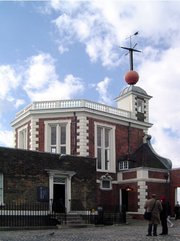Royal Greenwich Observatory
|
|
The original site of the Royal Greenwich Observatory (RGO), which was built as a workplace for the Astronomer Royal, was on a hill in Greenwich Park in Greenwich, London, overlooking the River Thames. The Prime Meridian, to which longitude refers, went through the observatory. It is marked by a brass strip in the courtyard and, since December 16, 1999, a powerful green laser shining north across the London night sky.
The observatory was commissioned in 1675 by King Charles II. Flamsteed House (1675-76), the original part of the Observatory, was designed by Sir Christopher Wren and was the first purpose-built scientific research facility in Britain.
The last time that all departments of the RGO were at Greenwich was before World War II. Many departments were evacuated along with the rest of London to the countryside (Abinger, Bradford, and Bath) in 1939. After the War, in 1947, the decision was made to move to Herstmonceux Castle and 320 adjacent acres (1.3 km²) (70 km south-southeast of Greenwich near Hailsham in East Sussex) due to light pollution in London. Although the Astronomer Royal moved to the castle in 1948, the scientific staff could not move until the completion of new observatory buildings in 1957. Shortly thereafter, other far flung departments were reintegrated at Herstmonceux.
RGO-Herstmonceux.jpg
The Isaac Newton Telescope was built there in 1967, but was moved to Roque de los Muchachos Observatory in Spain's Canary Islands in 1979. In 1990 the RGO moved again, to Cambridge. Following a decision of the Particle Physics and Astronomy Research Council, it closed in 1998. Her Majesty's Nautical Almanac Office was transferred to the Rutherford Appleton Laboratory after the closure. Other work went to the UK Astronomy Technology Centre in Edinburgh. The castle now houses the International Study Centre of Queen's University, Kingston, Canada and the Observatory Science Centre.
Greenwich Mean Time was at one time based on the time observations made at Greenwich, before being superseded by Coordinated Universal Time. While Greenwich no longer hosts a working astronomical observatory, it remains a centre of excellence for modern astronomy.
A time ball still drops daily to mark the exact moment of 1pm (13:00) - this was installed by Astronomer Royal John Pond in 1833. There is a good museum of astronomical and navigational tools, notably including John Harrison's prize-winning longitude chronometer, H4. In February 2005 construction work began on a Ł15 million redevelopment project which will provide a new planetarium and additional display galleries and educational facilities.
Chronology
- 1675 Royal Observatory founded.
- 1924 Hourly time signals (Greenwich Time Signal) from the Greenwich Observatory were first broadcast on February 5.
- 1948 Astronomer Royal moves to Herstmonceux.
- 1957 Royal Observatory completes its move to Herstmonceux, becoming the Royal Greenwich Observatory (RGO). The Greenwich site becomes the Old Royal Observatory.
- 1990 RGO moves to Cambridge.
- 1998 RGO closes. Greenwich site becomes the Royal Observatory, Greenwich, and is part of the National Maritime Museum.
Further reading
- Greenwich Observatory: ... the Royal Observatory at Greenwich and Herstmonceux, 1675-1975. London: Taylor & Francis, 1975 3v. (Vol. 1. Origins and early history (1675-1835), by Eric G. Forbes. ISBN 0-8506-6093-9; Vol. 2. Recent history (1836-1975), by A.J. Meadows. ISBN 0-8506-6094-7; Vol. 3. The buildings and instruments by Derek Howse. ISBN 0-8506-6095-5)
External links
- HM Nautical Almanac Office (http://www.nao.rl.ac.uk/)
- The Royal Observatory, Greenwich (http://www.rog.nmm.ac.uk/)
- The National Maritime Museum (http://www.nmm.ac.uk/)
- The RGO at Herstmonceux (http://www.cowbeech.force9.co.uk/RGO.htm)
- The Observatory Science Centre (http://www.the-observatory.org/)
- Isaac Newton Group of Telescopes (http://www.ing.iac.es)cy:Yr Arsyllfa Frenhinol, Greenwich
de:Royal Greenwich Observatory nl:Koninklijk Greenwich Observatorium ja:グリニッジ天文台 he:מצפה הכוכבים המלכותי של גריניץ'

